Costs of Producing Biogas at Dairy Farms in The Netherlands
Warning: Undefined variable $tagger in /var/www/bioenergypro.com/public_html/bioenergy-articles/snews.php on line 2924
Warning: Undefined array key "https://www.bioenergypro.com/bioenergy-articles/Logged_In" in /var/www/bioenergypro.com/public_html/bioenergy-articles/snews.php on line 2999
1 Introduction
Anaerobic digestion of organic wastes and by‐products from agriculture and the food industry is a process
known for many years and is widely used for waste stabilization, pollution control, improvement of
manure quality and biogas production (Weiland, 2006). Biogas production from manure contributes to
climate protection by reducing emissions of CO2 via substitution of fossil fuels and by reducing CH4
emissions from the manure during storage (Moller et al., 2007). It is expected that biogas production will
be instrumental in reaching European goals in the field of renewable energy. Due to the simultaneous
advantages of avoiding greenhouse gas emissions and producing energy (Sommer et al., 2004) as well as
reducing odor emissions (Hansen et al., 2006), there has been a rapid development in the use of biogas in
recent years (Weiland, 2006).
In the EU, where only about 5% of the gross consumption is made up of renewables, which is lower than observed in other parts of the world, the share of renewables is expected to double by 2010, and the share of biogas, as part of it, is expected to rise to 12% (Nielsen, Al Seadi, 2006). The Dutch government, in its white paper on energy calls for a simultaneous approach of continuous energy savings, a 30% improvement of efficiency by 2020 and a 20% share of renewable energy in 2020 (Kwant, 2003). In the Netherlands, the potential of energy production from biogas has been estimated to be 49 PJ in 2020 (Nielsen, Al Seadi, 2006).
As part of the “clean and efficient” program, the Dutch dairy chain is aiming to achieve an energy‐neutral production. This new initiative, hereafter called as the energy‐neutral milk initiative, aims at bringing the whole chain, i.e. from the dairy farm to the factory, ultimately to be self sufficient in energy in 2020. This is envisaged to be achieved by building fermentation units to convert manure and food waste into biogas, which can then be used (directly or indirectly) by local dairy factories. The energy consumption in the dairy chain for milk production and processing is estimated to be 25 PJ per annum excluding energy consumed for feed and artificial fertilizers. Our analyses aim to estimate the aggregated costs of producing this amount of energy at farm level. We herewith consider various business models varying in size and output.
In analyzing the feasibility of biogas plants, a mix of variables is relevant as economic efficiency of anaerobic digestion depends on among others investment costs, the costs of operating the biogas plant and the optimum methane production (Chynoweth, 2004; Walla, Schneeberger, 2005). A maximum methane yield is especially important with the digestion of energy crops as these (in contrast to animal manures or organic wastes) have production costs that have to be covered by the methane production (Walla, Schneeberger, 2009). So far, feasibility studies of biogas plants generally use only a limited amount of practical data, see for instance Georgakakis et al. (2003), Singh and Sooch (2003), Svensson et al. (2005) and Svensson et al. (2006). In our study we use cross‐sectional data of 23 farm level biogas plants located in the Netherlands.
2 Review of literature
Biogas produced in anaerobic digestion (AD) plants is primarily composed of methane (CH4) and carbon
dioxide (C02) with smaller amounts of hydrogen sulphide (H2S), ammonia (NH3) and other particles
(Persson et al., 2006). A lot of fermentation plants have been built, particularly in Denmark, Germany and
Sweden, with capacities varying from 10,000 tons of biomass/year to around 150,000 tons/year. In the
Netherlands these plants tend to be capable of processing 2000‐4000 tons/year (for a single farm) up to
around 36,000 tons/year (Wempe, Dumont, 2008)1. Existing plants vary greatly in size and design. The
large‐scale processing of residual products, for example from the food industry and agricultural sector,
also allows biogas to be produced on an industrial scale. Table 1 depicts technical and financial data of
farm and large‐scale operating biogas plants equipped with combined heat and power (CHP) units from
different sources.
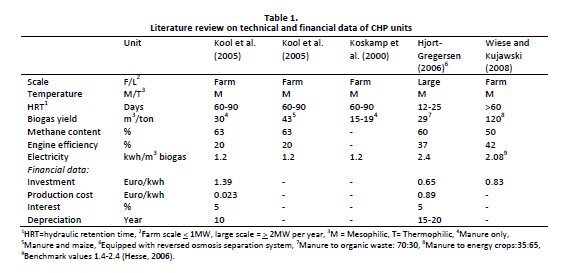
To date, almost all of the biogas produced worldwide is used for electricity and heat production (Borjesson, Mattiasson, 2008). Of the heat produced, around 35% is used to heat the plant itself. The remainder cannot always be used locally and is often released into the air, thus resulting in the energetic return (efficiency) falling from 90% to 65% (Vries, Burgel, 2005). The alternative route with much higher energy utilization efficiency would be converting the biogas into natural gas by means of a suitable biogas upgrading process and to feed the upgraded biogas into the natural gas grid. When the gas is fed to the grid, it has to meet energy standards which usually require 97% methane (Persson et al., 2006). In this paper, this upgraded biogas will be referred to as “green gas”. There are various technologies that can be used for upgrading of biogas into green gas; the most common technologies being the water scrubber technology and the pressure swing adsorption (PSA) technology (Jonsson, 2004). The main step in the upgrading process is the separation of carbon dioxide from the methane gas in order to reach the required Wobbe index or heating value of the gas (Persson et al., 2006). Table 2 shows an overview of technical and financial data of upgrading biogas at varying scales. Data are from feasibility studies; except the study by Dirkse (2007) which reports data from an operating plant in Tilburg, the Netherlands.
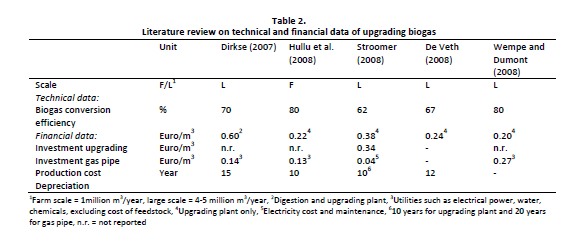
3 Materials and methods
3.1 Data collection
Data on selected parameters were gathered from 23 operating biogas plants in the Netherlands. All plants
are CHP unit plants. Consolidated results from data acquisition and analysis are shown in Table 3. The
amount of substrate processed varies between less than 5,000 ton/year in the smallest installation up to
63,000 ton/year in large plants. Most of the plants (more than 70%) are farm‐scale plants with a biomass
digestion capacity of up to 36,000 ton/year. Biogas yields range from 70 to 182 m3/ton. The majority of
the digestion is carried out at mesophicilic temperatures with two plants having temperatures greater
than 50oC. The lowest electrical efficiency is 31%, while one plant achieves an efficiency of over 40%.
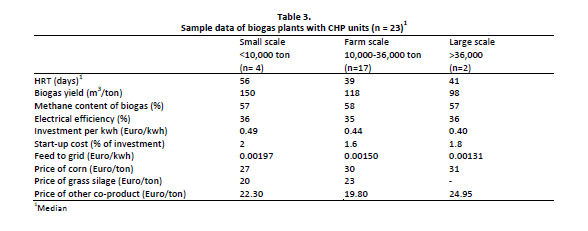
The majority of the plants uses cattle manure as the main feedstock with a share of 50% of the incoming materials. Three plants operate with fermentation of pig manure and other co‐digestion materials. Energy maize and grass silage are the dominant feedstocks used for co‐fermentation. Other co‐digestion materials include weed, potatoes, vegetables mix, glycerin, solid fraction digestate and expired products from supermarkets. Besides cattle manure some plants also use horse and chicken manure. Investment costs refer to the total of the whole installation inclusive of silos, digester, CHP unit and civil works. All the plants are under the MEP2 subsidy and the majority started operation in 2006/2007. Data refer to 2008.
3.2 Business models
To produce the 25 PJ energy required by the dairy chain from AD of biomass, possible business models
including their likelihood of occurrence were determined in consultation with stakeholders. Stakeholders
were from sector and research organizations, industry, financial institutions and government. Key
considerations were heat utilization, feedstocks digested and size of plants. Heat produced by biogas
plants should be properly utilized to get permits and subsidy. Proper heat utilization is described as
avoiding excessive flaring of heat to the air. Table 4 shows the four business models that are deemed to
be possible in the future. For each business model, production capacity, required investments and inputs
and outputs are outlined. Business models are categorized according to size (farm‐scale versus large scale)
and output type (electricity versus green gas).
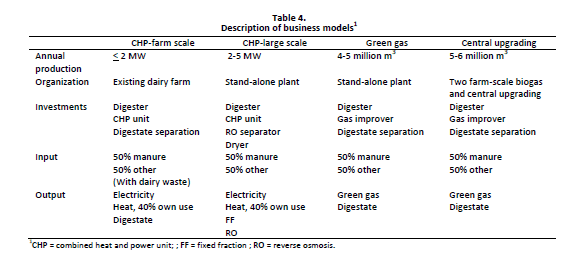
Farm‐scale CHP plants have a production capacity of up to 2 MW of electricity built on an existing dairy farm. The substrate mixture comprises of 50% dairy manure and 50% other co‐substrates in all models. The farm‐scale CHP model uses dairy processing waste as an input. Large‐scale CHP‐models have a production capacity of 2‐5 MW of electricity. Investments depend on the final output; electricity and heat (CHP unit) or green gas (upgrading). The large‐scale CHP model is equipped with a reverse osmosis (RO) separator and dryer to ensure that heat produced by the plant is properly utilized within the plant, i.e. to heat the digester and dry the digestate. In the central upgrading model, two farm‐scale digestion plants will deliver biogas to a central upgrading unit which will then upgrade the gas and feed it to the gas grid.
3.3 Financial model and assumptions
Key project variables in the biogas model are investment costs, price of feedstocks, biogas yields, subsidy
levels of electricity and green gas and disposal costs of digestate. Table 5 lists the variables along with
their unit of measurement and source. Variables for which sample data could not be used are modeled
based on literature and expert opinion. This is for instance the case for investment costs of green gas
upgrading equipments. Historical energy maize prices were obtained from LEI (2008). For grass silage and
other products, data from the operating biogas plants are used to define relevant values. With regard to
energy prices, the new SDE3 level for electricity and green gas of Euro 15.2 ct/kwh and Euro 58.30 ct/m3 respectively are assumed. SDE amounts include the base price of Euro 4.4 ct/kwh and Euro 14.7 ct/m3 for
electricity and green gas respectively (VROM, 2009). RO concentrate (CHP‐large) is considered as animal
manure with a disposal cost of Euro 8/ton while the dried fraction (80% dry matter) is disposed of at no
cost.

When modeling the technical and financial performance of the various business models, a number of assumptions was made. The plants operate with fermentation of cattle manure, energy maize, grass silage and other co‐digestion materials (including dairy waste in the case of CHP farm‐scale) with a share of 50%, 15%, 10% and 25% of the total incoming materials respectively. This substrate composition is comparable to the 23 operating biogas plants. With fermentation taking place at mesophilic temperatures average biogas yields are estimated to be 118 m3/ton of feedstock. Digestate is partly (50%) applied on own land in the farm‐scale model and the rest is delivered to other farms. Furthermore, we assume that 40% of the heat is used within the plant to heat the digester and dry the digestate; the rest is lost to the air. In addition, it is assumed that plants will be able to use the existing public net (so deliver indirectly to dairy processors). Of the total electricity and green gas produced, 10% is used within the plant while the rest is fed to the grid.
3.4 Scenarios for upgrading to 25 PJ per year
In the default scenario all parameters are as described in the previous section. Also, it is assumed that, to
produce the 25 PJ of energy required by the dairy chain, a large portion (60%) is produced by green gas
models and the remaining 40% by CHP models with CHP‐farm and CHP‐large each having a share of 30%
and 10% respectively. This assumption is deemed to be plausible as the prospects of an upgrading plant
are better compared to a CHP unit, because of its potential to avoid excessive loss of heat to air and the
new relatively high subsidies for green gas. The RO as green fertilizer scenario assumes that in the CHPlarge
model the RO is treated as green fertilizer replacing artificial fertilizers and a market price of Euro
5/ton excluding costs of transport. In the higher subsidy scenario it is assumed that prices of green
electricity increase to Euro 17.7 ct/kwh while for green gas rates stay the same. Higher prices for
electricity are possible in case of a better utilization of the heat. The green gas only scenario assumes that
all the energy will be produced from green gas only as the prospects of green gas are promising in terms
of energy efficiency and relatively higher subsidies. The likelihood of the business models in this scenario
is 50% for the green gas model and 50% for the central upgrading model.
4 Results
4.1 Technical results
Technical results (Table 6) are presented in terms of the estimated total tons of feedstocks digested,
electricity, heat, green gas and digestate produced. Given the estimated average biogas yield and
conversion efficiencies as outlined in Table 5, the CHP farm‐scale model requires 36,000 tons of feedstock
while the large‐scale models require about 64,000 tons of feedstock to produce the required amount of
energy. The mixture of substrates will yield 8.70 million kwh (around 1.12 MW assuming 7800 operating
hours per year) in the farm‐scale model and 15.26 million kwh (around 2 MW) in the large‐scale CHP. In
the green gas models, yields are 4.5 million m3 and 5.35 million m3 of green gas.
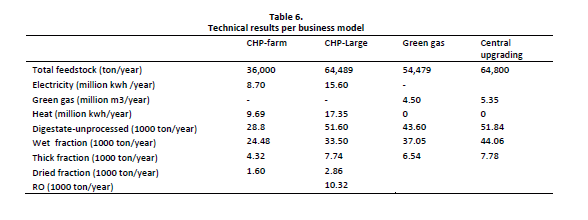
4.2 Financial results
The financial results of each business model are summarized in Table 7. Investment figures show that
investments are estimated to be highest for the CHP‐large plant (Euro 7.7 million) and lowest for the
green gas plant (Euro 2.7 million). Estimated revenues and costs are highest in case of the central
upgrading: Euro 3.1 million and Euro 2.85 million respectively. Expected operating profits are positive for
2 business models, i.e. green gas and central upgrading. For the CHP plants, expected revenues are not
sufficient to recover expected costs. When calculating the net present value with time horizons between
15 and 20 years, values for both CHP‐models become negative. Clearly, the higher efficiency of green gas
models (no heat loss) and the—related—relatively high levels of subsidy for the amount of green gas
produced make these models more attractive.
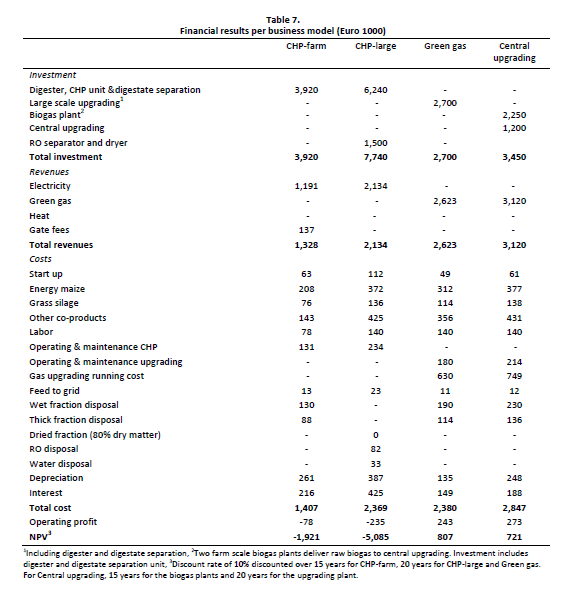
4.3 Aggregated results for upgrading to 25 PJ
As the ultimate “energy goal” of the dairy chain is to produce 25 PJ per year, we also estimated the total
number of business models that needs to be in operation to achieve this, including the expected annual
profitability and the economic viability over the plants’ life time (Table 8). In the default scenario, in which
we assume, based on the stakeholder opinions, that the CHP‐farm, CHP‐large, green gas and central
upgrading models occur with probabilities of 30%, 10%, 35% and 25% respectively, a total of 216 models
would be needed to produce the energy required. In terms of number of plants this would be 232, as
central upgrading models consist of 2 farm‐level biogas plants. This amounts to about 1% of dairy farms in
the Netherlands. Considering 50% of feedstocks to be cattle manure, the total amount of manure needed
sums up to 5 million tons, which is about 14% of the total amount of cattle manure produced in the
Netherlands.
Total SDE subsidies involved would be Euro 295 million per year (number of business models x energy produced x subsidy per kwh and m3). Yet, despite a positive profitability on an annual basis (Euro 7 million at the aggregate level) we expect a deficit of Euro 262 million over the project’s total lifetime. So, more subsidy would be needed, or, alternatively, input costs or digestate disposal costs would for instance have to decrease. Getting RO accepted as green fertilizer in the CHP‐large model (accounting for 10% in the total share) does not contribute much—in terms of the financial viability of the aggregate picture. However, if subsidies in the CHP‐models, i.e. subsidies for green electricity, would increase to the upper level indicated in the policy paper, the whole picture is expected to change, i.e. into positive figures both for profitability (Euro 44 million per year) and net present value (Euro 7 million). In practice however this would require higher heat usage which would likely also involve additional investments. If the 25 PJ would be produced by green gas models only, the number of business models is reduced to 135 (with the number of plants reducing to 166) due to the higher efficiency of green gas plants. Also, the financial viability would further improve.
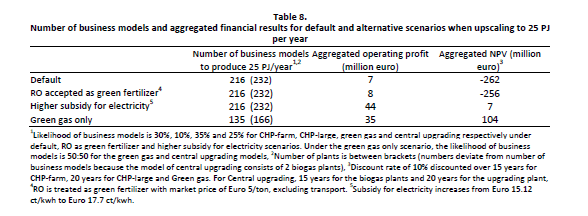
5 Conclusions and discussion
This paper presents a profitability analysis of the energy‐neutral milk initiative by the dairy sector in the
Netherlands. In order to produce the aggregated amount of 25 PJ of energy per year, relevant
input/output coefficients, investment costs and operational revenues and costs were determined for 4
business models.
From the findings, the following conclusions can be drawn:
1) In the default scenario the production of 25 PJ of energy resulted in an expected operating profit of
Euro 7 million and an expected NPV of minus Euro 262 million. Although the project resulted in a mean
positive operating profit, the profits were not high enough to cover the investment cost (negative
NPV). The high operating profit (Euro 35 million) and NPV (Euro 104 million) under the “green gas only
scenario” are attributed to the high efficiency of upgrading gas as compared to CHP units and the
current relatively high subsidy levels per m3 of green gas.
2) Key issues for determining the economic viability of the project can be looked at from an input, process
and output perspective. From an input and process side, investment costs, biogas yield and price of codigestion
materials are important determinants of economic success. Higher biogas yields are
particularly essential as the costs of co‐digestion materials (production cost) have to be covered by
these yields. Subsidy levels and the price of digestates (including RO) are important output related
factors contributing to financial viability.
Analyses also bring forward a number of discussion points:
1) Various data sources were utilized to estimate the input and output coefficients. Technical and economic data from 23 operating biogas plants were used to estimate biogas yields, engine efficiencies and the required investments related to CHP units. However, since the majority of these plants are in a starting‐up phase, we only used data of one year (cross‐sectional) to estimate our parameters. Parameters related to upgrading gas mostly came from literature and expert opinions. If more data become available the model can be updated.
2) The current study is set up in a deterministic way. Empirical data however indicate that substantial variation exists on a number of parameters, such as with respect to start‐up costs and biogas yields per ton of input. To account for this variation, further analyses are underway to incorporate risk in order to provide dairy chain decision makers not only with expected values but also with the more optimistic and pessimistic situations.
3) Economic results of the CHP‐large model suggest that the model is not economically viable. However, a previous case study of Biogreen (Gebrezgabher et al., 2009) found a positive NPV for a large CHP unit equipped with an RO installation when RO is treated as green fertilizer. The positive result obtained in the case study as opposed to the current study is due to higher gate fees for pig manure, flower bulbs and poultry manure, received by the plant. In the current study it is assumed that no gate fees are received for dairy manure or other co‐products. This suggests that analyses of biogas plants are relatively case‐specific, which is a further plea to incorporate risk in evaluating the viability of largescale projects such as envisaged by Dutch dairy chains.
by Solomie A. Gebrezgabher, Miranda P.M. Meuwissen and Alfons G.J.M. Oude Lansink
This article hasn't been commented yet.


Write a comment
* = required field